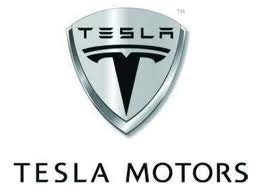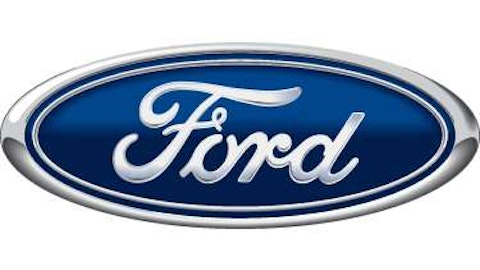Tesla Motors Inc (NASDAQ:TSLA) is on track this year to produce north of 20,000 units annually in North America. It has also been producing vehicles for export to Europe with volumes of nearly 200 per week. Tesla sees the cars that it’s exporting now as a great marketing tool. These few cars can increase demand based on their exclusivity factor and word-of-mouth references. With demand outstripping supply for the foreseeable future, Tesla Motors Inc (NASDAQ:TSLA) will see growing margins and growing production. But, is the stock too rich to make investors any money at this rate?
Production
Tesla’s highly efficient designs aren’t just being used in-house anymore. Toyota Motor Corporation (ADR) (NYSE:TM) is using power trains created by Tesla to power its recent electric RAV4. Deals like this help Tesla diversify its revenue streams and increase its volumes to gain bigger supplier discounts. Toyota recognizes that it can either spend thousands of man hours designing and creating its own power trains, or it can license out the leading technology. Toyota Motor Corporation (ADR) (NYSE:TM) can still utilize its sales network and gain volume discounts from suppliers; this sales network is one of Toyota’s strongest moats against up-and-comers like Tesla Motors Inc (NASDAQ:TSLA).
Toyota Motor Corporation (ADR) (NYSE:TM) and Tesla are in two separate markets as of right now, but as battery technology reduces costs, these two companies could be going head-to-head. Currently Toyota focuses on mass-market green vehicles, like the Prius. Toyota’s flagship green vehicle pales in comparison to Tesla on all measurable fronts, but Tesla Motors Inc (NASDAQ:TSLA)’s reliance on expensive batteries makes the car available only to the wealthy.
Toyota Motor Corporation (ADR) (NYSE:TM)’s global scale is a double-edged sword; the automaker has invested billions of dollars in plants and equipment. If Tesla’s vehicles come down in price over the next few years to compete against vehicles like the Prius, Toyota will see shrinking margins and market share.
Tesla aims to end the year near an annualized vehicle-production rate of 23,000 to 25,000, far below that of the Prius’ 320,000 units produced in 2012. Tesla is currently working on improving logistics costs and process improvements to increase production levels to 20,000 per shift in 2014. This means that if Tesla runs two shifts on a full-year basis, the car company could scale up to 40,000 units per year with its current plants, barring any supplier issues. Increasing production anywhere beyond the 40,000 mark would require an additional investment in factory space by Tesla Motors Inc (NASDAQ:TSLA).
Infrastructure
The feeling of being stranded on the highway with no electrical outlet to be found is referred to as range anxiety, and it remains an issue for electric cars. Automakers are trying to identify ways to relieve this in different ways. Tesla’s vehicles use long-range batteries that can go nearly 300 miles per full charge and a network of supercharging stations. On the other hand, vehicles like the Chevy Volt use a backup on-board gas generator to generate electricity when the battery runs low.
As Tesla sells more vehicles, there will be increased demand for these supercharging stations that can power a vehicle to half charge in 30 minutes, enough time to grab a bite to eat and stretch your legs.
Automakers are facing strict guidelines on fuel economy ranges that their fleets must attain. How are automakers like General Motors Company (NYSE:GM) supposed to comply with the increased fuel-economy laws? The easy answer is to purchase credits from other companies. Since Tesla Motors Inc (NASDAQ:TSLA) earns credits on each vehicle it sells, it can then turn around and sell the credits to manufacturers that will have a harder time bringing their truck fleets up to compliance. The downside of this equation is that it will put pressure on GM’s profit margin, as the company will have the added expense of purchasing these credits.
General Motors Company (NYSE:GM) has been able to increase the efficiency of its trucks with mild hybrid systems and cylinder deactivation. However, the bottom line is that a truck is a vehicle that is less aerodynamic and heavier than a sedan, and will most likely need to be offset with highly efficient lines like the volt. The other way to supplement its fleet’s fuel efficiency is by purchasing credits from other manufacturers. Then GM will be able to sell its bread-and-butter trucks even if its cars don’t totally bring up fuel efficiency. This provides yet another stream of revenue to Tesla.
Rigid company
General Motors Company (NYSE:GM) still has a heavy reliance on unionized labor, for better or worse. This makes GM a more rigid company that is not able to lay off or hire workers with the ebbs and flows of the worldwide economy. These massive fixed costs have made this company slower to react than most, and will continue to do so into the future. GM’s European units are prime examples of this rigidity.
As demand in Europe slowed, GM was not able to shed workers to stay profitable. General Motors Company (NYSE:GM)’s loss in Europe in 2011 was $294 million, while 2012 improved to a loss of $175 million. GM was not able to reduce its workforce to properly align supply with demand as the European economy slowed. The improvement in GM’s loss can be attributed to the regional economy recovering this year, and GM is hoping to break even in the region this year. If it weren’t for the strength of the US and Asian economies, General Motors Company (NYSE:GM) could have posted large losses, potentially putting the company back on the path to bankruptcy.
As a smaller company, Tesla will be able to make changes to its workforce more readily than the previously bankrupt GM. This flexibility should benefit Tesla Motors Inc (NASDAQ:TSLA) should another recession hit.
Valuation
Currently Toyota is one of the most valued car companies in the world. Toyota Motor Corporation (ADR) (NYSE:TM) is currently trading at a P/E of 25, while the number-two car company in the world, General Motors Company (NYSE:GM), is trading at a multiple of 12. Both Toyota and GM have profit margins slightly lower than 3%.
On the other hand, Tesla eked out its first positive earnings in the first quarter and is still hovering around the break-even mark for the next few quarters.
Tesla Motors Inc (NASDAQ:TSLA) went from one of the most shorted stocks traded in America to a rocket ship, shooting up more than 210% since the beginning of the year. As traders shorting the stock had to scramble and cover their positions, they were forced to purchase the stock at higher and higher prices. This is known as a “short squeeze,” and it is the main reason for Tesla’s meteoric rise.
Foolish bottom line
Tesla has a solid business model, and is capitalizing on both selling its product, and supporting the old-guard car companies by selling its zero-emission vehicle credits. These multiple revenue streams will keep cash flowing into Tesla, and keep the company producing some of the sportiest and most efficient cars on the road today. As an investment, Tesla’s stock has gotten well ahead of itself. As Tesla ramps up production, it will take years for the fundamentals to catch up to the stock price at current levels, leaving more downside risk than upside speculation.
Wes Patoka has no position in any stocks mentioned. The Motley Fool recommends General Motors Company (NYSE:GM) and Tesla Motors . The Motley Fool owns shares of Tesla Motors Inc (NASDAQ:TSLA).
The article Tesla’s Future Looks Promising, but at What Cost? originally appeared on Fool.com.
Wes is a member of The Motley Fool Blog Network — entries represent the personal opinion of the blogger and are not formally edited.
Copyright © 1995 – 2013 The Motley Fool, LLC. All rights reserved. The Motley Fool has a disclosure policy.




